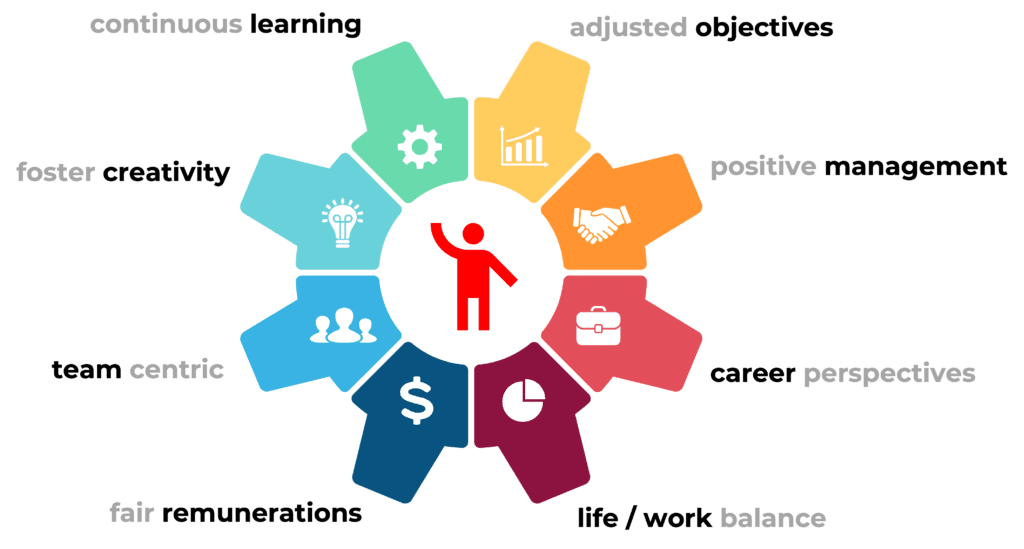Executive Leadership
& videogaming consulting services
Business
effectivness
Staff
centric
Creative
mindset
Operational
efficiency
Need help…?
… to be more
Staff centric
Employees’ happiness is key. Even more so in creative structures. Not only because we’re in 2024 after a post-covid / 100% home-office time… or because it is trendy these days.
But because your staff is the most valuable part of the company. You —we all— know it by now. But we actually never really act enough to make it real.
Like you —very logically— your employees give their best when they are in a happy mood.
SHARE THE VISION
First things first : clearly communicate the company’s vision, its long term goals, and short term objectives is key.
This helps employees understand what you want, and how & why their daily work will make a difference.
Make them part of the plan. If they’re part of the plan, they will not fight the plan: they’ll fight for it!
What to do…
- assess if you and your staff are communicating enough & help to adjust
- find out wether or not your staff is happy, satisfied by the company polices and directions
- make sure that vision explained is the same than the stakeholder’s one
COMPANY CULTURE
It might seems obvious, but spending serious time and effort in fostering positive, inclusive and collaborative culture is key.
Positive work culture like teamwork, creativity, empowerment and continuous learning should indeed be actively encouraged. A great and well-structured HR team, working with all management lines can do miracle in that field.
On top of HR & managers, proper tools need to be available: tailored appraisal process, timely team-building events, proper management training, health programs, help on mental health and work-life balance… All those needs should be setup and / or regularly reassessed to make sure they serve the staff and the company purpose well enough.
-> It can also be interesting to setup official ‘core values’; if possible together with your staff. Never forget that it is a two-sided thing and can backfire if wrongfully / excessively used.
Promote respect toward people, and also toward the company. Remind to everyone that the common good comes before individual interests. One of the main mission of the leaders is to make sure that the company is viable and secure people’s job.
What to do…
- Already busy in providing a better work environment? If not, you are already behind schedule! And if you are, you probably should try harder anyway 🙂
- Improve the cohesion of the team(s) around the company project(s) and around the company values
- Ensure that there is a mutual respect between staff & company

EMPOWERMENT & AUTONOMY
Theoriticaly you have hired people better than you —if not, there’s a problem but that’s another topic.
You should therefore trust your teams and give them the means they need to perform in their field. Give them power. And freedom.
But here again, do it at the right time: not too early if they need training & coaching, and not too much either: they are not here to let you get rid of your responsibilities. You must remain involved through well-identified non-heavy processes.
Always remember: they are not here to do your job, just their’s (and that’s often a lot already).
Empowerment is not letting people unmanaged; true empowerment is well-thought out, organized (job description, appraisals…) and regularly monitored.
When properly done, it works wonders.
What to do…
- clarify & smoothen the company structure and processes –> your staff will save a lot of time and effort to understand who is responsible of what.
- make sure the right responsibilities are properly identified and spread throughout the organisation, and land on the competent persons
- set-up a proper training management course for all the managers within the company. Weird enough, management is considered as a natural talent that everybody get, while it is far from being the case;
Need help…?
… to expand your company’s
Creative mindset
SECRET INGREDIENTS
Creativity needs several ingredients to flourish: talented people, stress-free environment, optimistic mind-set, positive company culture, time, tools…
On top of being stimulated by the right ‘ingredients’, creativity produces the best results when properly driven.
Depending company’s objectives and means available —often synonymous of time in this case— the managers have to find the tailored creative processes that will ease objectives’ completion.
It can be Game Jam, long-term (friendly) competition, regular brainstorming sessions (cross-disciplines or not…), internal small ‘lab’ setup as an official creative R&D entity… or more likely a specific mix of those solutions…
What to do…
- create enough space for innovation, taking into account company’s objectives and means
- check if innovation & creativity concepts are well-understood by your crew —at all levels—, to avoid misunderstanding. Adjust if necessary.
- help to incorporate step-by-step the various ingredients needed to unleash creativity on the long run
BLOOMING EVERYWHERE
Creativity can shine everywhere: in lines of code, in art assets, in production processes, in management and leadership approaches, in business strategy…
We saw this during and after Covid times: creativity is needed in all disciplines in order to have an agile and resilient company.
Being able to adapt the company production to the end-users tastes and also to the industry hazards is fundamental for a company now days.
What to do…
- is creativity facilitated everywhere in your company?
- or just in the traditional disciplines?
- are innovation & creativity part of the objectives of your teams?
- do you need help to explain & structure the creative needs of your company?
SELECT… and IMPLEMENT
A creative company can produce new ideas and innovations, but that’s… 25% of the creative effort.
The other 75% are the capacity to sort the great ideas from the good ones, to select the one really bringing something to the mix, to explain them well enough to convince everyone to move forward with them…
And then afterwards to concretely act & implement those innovations in a steady way through various company adjustements. Till results.
Like the old saying regarding success, creativity often is 5% of brand new ideas and 95% efforts to make them happen: being creative with nothing coming out of it is actually not being creative.
Real creativity makes things happen!
What to do…
- Is your company ready to select and promote the new ideas in a consistant and proper way?
- Do you think your crew —and yourself— understands creativity and innovation in the right way?
- Do you have several concrete / visible examples of your company innovations in head? Did it help to make a difference?
Need help…?
… to obtain better
Operational efficiency
INSPIRING LEADERSHIP & GREAT MANAGERS
Structured, optimistic & energetic management layers are key. Once you have set the right direction, they are the ones who make it happens. They take over your vision, and they give right pace & energy toward objectives deliveries.
You therefore need reliable, talented and energetic managers. Don’t fear the pushy ones, but rather the too quiet ones: it is easier to channel energy rather than create it!
On top of being talented, your managers and especially your Executives need 3 major qualities:
- Optimistim
- Consistancy
- Reliablity
Consistancy is particularly important in my opinion. A lot of people can perform well for 4 to 6 months. But being a constant reliable and optimistic individual that inspires other thought the years, that’s really another league.
In order to succeed in setting up the right management teams, instinct, common sense and trust in what’s working in other places are important tools for you. Smartness is in the mix. And being aware that particularly with people, several tentatives are often needed to get the right team in place.
At the end of the day, the main mission of the leaders is to make sure that the company is viable and heads the right direction.
What to do…
- Are all your management layers performing?
- Can you feel common-sense being used at all levels?
- Is optimism and energy pouring out on a daily basis from your Execs?
- Does everyone get the right amount of coaching and of information they need?
- Is there enough team-building effort made with your existing crew?
HORIZONTAL AND VERTICAL MANAGEMENT
Executives, mid-management lines, team leaders… they should all be logically connected and well synced.
Horizontal management is trendy, but on the long run it is now known that it can severely backfire if not mixed with vertical decisions and authority (see more about that in HBR articles and MIT books, notably by Lindy Greer or Robert I. Sutton).
Finding the balance here is absolutely vital. It requires experience and hindsight, and is usually an Executive duty
What to do…
- are those notions properly understood in your company?
- do you have regular Exec. meeting to exchange experience
- have all your managers had enough training & coaching sessions?

COMMON SENSE PROCESSES
Making common sense common practice is especially needed regarding processes. How many times a process has been setup to help to put things in order, but failed miserably at end, becoming only time consuming and meaningless?
Processes and procedures have to be smart, logic and easy to follow. They also need to be understood.
I personnaly favor very straightforward and common sens based management & processes. It might sometimes feel a little bit less elaborate than what it should be, but in this case keeping things simple is defnitively better than creating complexity. A good example is the Eisenhower Matrix: easy to explain, easy to understand, it is useful for everyone in the company. Including for the Executives.
Simple ‘common-sense proof’ processes & methodologies should be set-up wherever it is needed to share a work methodology. But only where it is the case: quantity is here again the enemy of quality (and usage).
What to do…
- Have you a clear set of processes properly documented and runing?
- Is there any complaints about those? If so, what is their nature?
- Do you think there’s too much processes in your company? Or not enough?
- Ask newcomers to give you a feedback on this matter after 1 month in the company: the good processes should be understandable by newbies, not just by the old crew who set them up.
ENGAGEMENT, RESPECT & OPTIMISM!
Spark engagement by giving a clear and believable vision, by making sense with your arguments, and by providing the toolset needed to achieve it.
Gain respect by genuinely listening to all voices, weighting all opinions, and then by making the right decision for the group when time has come.
Fuel everyone with optimism and be consistant with the energy and direction you’re giving.
An important thing to remind to your crew: respect is a 2 side thing. Make sure to enhance the company’s respect toward your staff members, but don’t be shy to promote respect toward the company as well. The common good of the whole staff comes before individual interests. Balance is key.
What to do…
- Do you think your crew truely understand the company challenges, and the various decisions you are making?
- Observe staff reaction in Salck channels, during big meetings, at company events… Do they enjoy being in the company?
- Do you or your manager receive significant amount of proposal to improve the process, the products, the work environement?
- Work with HR to have a plan to improve work conditions on the long run. It can be spread over the years: your crew will understand.
- Create moments and channels where people can express all their ideas and mood, and mak sure to provide feedback and perspective.
from simple advices on specific topics to full company support
My name is Dominique Morel, and since almost 20 years I am specialized in teaming-up with C-level leaders to help them in their daily challenges.
I offer a wide range of executive business and management services, all meant to help your company and its products to reach their potential. Whether you are looking for a short specific help, or for a more global permanent support, I’ll have you covered.
My network and expertise in the gaming as well as in the ‘serious software’ industry will either bring you immediate results for specific topics, and / or will drastically optimize your existing processes and structure, allowing you to meet deadlines and quality.

Passion

Hot facts
> each company is unique
• understand the project, the people, the motivation, the constraints, the ressources… Key elements for a success
> understand the big picture
• properly grasp company’s vision and the main real goal of a company is key to succeed.
> great staff make great projects
• find the talents that fit your goals. Nothing is possible without great people. And make them happy.
> focus
• as simple as it may sound, this is often where companies fail. Saying ‘no’ to the unnecessary, AND outperform on the core will make your company shine

